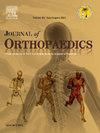Prognostic factors for disease progression of central high-grade conventional osteosarcoma of the appendicular skeleton: Single-centre experience within South Africa with minimum 3-year follow-up
IF 1.5
Q3 ORTHOPEDICS
引用次数: 0
Abstract
Background
Disease progression (DP) of osteosarcomas, albeit with aggressive treatments, hinders improving survival. The DP patterns are unique in low- and middle-income countries like South Africa. We determine the prognostic factors associated with disease progression (DP) of the appendicular skeleton's central high-grade conventional osteosarcoma (COS).
Methods
This is a retrospective study of 77 patients, with a minimum 3-year follow-up period diagnosed with histological biopsy-confirmed COS. Descriptive statistics, Cox proportional regression modelling, and the Kaplan-Meier method were employed for the analysis.
Results
DP occurred in 75 % of patients (58/77), either as a local progression - LP 32 % (25/77), systemic progression – SP 61 % (47/77) or both 32 % (24/77). In the univariate analysis, the factors associated with DP were proximal humerus tumor site (hazard ratio [HR] 2.48; 95 % confidence interval [CI], 1.02 to 6.04; p < 0.046), metastasis at diagnosis (HR 1.91; 95 % CI, 1.10 to 3.32; p < 0.022), multiple metastatic lesions (HR 2.58; 95 % CI, 1.13 to 5.88; p < 0.024), curative treatment (HR 0.33; 95 % CI 0.17 to 0.62; p < 0.001), palliative treatment (HR 2.17; 95 % CI 1.24 to 3.78; p < 0.007), and wide surgical resection (HR 0.48, 95 % CI 0.27 to 0.86; p < 0.013). On multivariate analysis, only age >19 years was an independent risk factor (HR 1.04; 95 % CI 1.00 to 1.08; p < 0.034). The median survival time was 24 months, with an overall survival (OS) of 57.1 % at 3 years. The projected Kaplan- Meier 5-year OS rate was 29.78 %, with a progression-free survival (PFS) rate of 10.28 % (HR 0.76; 95 % CI 0.52 to 1.112; p < 0.128).
Conclusion
In this series of central high-grade conventional osteosarcoma of the appendicular skeleton from South Africa, we observed a uniquely high proportion of disease progression (DP). Age >19, metastatic disease, and no chemotherapy response yielded poor outcomes; in contrast, wide surgical resection is beneficial. Further elucidation is needed at a larger scale in this region.
Study evidence level
IV.
求助全文
约1分钟内获得全文
求助全文
来源期刊

Journal of orthopaedics
ORTHOPEDICS-
CiteScore
3.50
自引率
6.70%
发文量
202
审稿时长
56 days
期刊介绍:
Journal of Orthopaedics aims to be a leading journal in orthopaedics and contribute towards the improvement of quality of orthopedic health care. The journal publishes original research work and review articles related to different aspects of orthopaedics including Arthroplasty, Arthroscopy, Sports Medicine, Trauma, Spine and Spinal deformities, Pediatric orthopaedics, limb reconstruction procedures, hand surgery, and orthopaedic oncology. It also publishes articles on continuing education, health-related information, case reports and letters to the editor. It is requested to note that the journal has an international readership and all submissions should be aimed at specifying something about the setting in which the work was conducted. Authors must also provide any specific reasons for the research and also provide an elaborate description of the results.
 求助内容:
求助内容: 应助结果提醒方式:
应助结果提醒方式:


